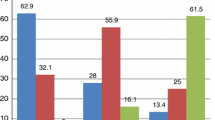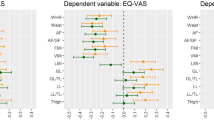Abstract
Quality of life (QOL) is associated with body mass index (BMI). Self-awareness of false body image may influence the behavior of weight control and QOL. This study was conducted to identify the relationships between BMI and QOL, and distortion of self-estimated body image and its impact on QOL and the general health of Korean adults. A total of 229 adults who visited two university hospitals in Seoul and Chungju cities for regular health check-up responded to a questionnaire. To assess QOL, a Korean version of the obesity-related Quality of Life Scale (KOQOL) was used. The results showed that obesity-related quality of life decreased as BMI increased and as alcohol consumption became heavier. In the low weight and normal body weight groups, a portion of the groups had a more obese self-estimated body image than their actual BMI. In the overweight and obese groups, some had a leaner self-estimated body image than their actual BMI. Persons who had a self-body image of being fat had a low QOL. For Korean adults over 20 and under 65, a higher BMI is associated with a lower obesity-related quality of life. Persons who thought themselves fat had a lower QOL, regardless of their real body type.
Similar content being viewed by others
References
Albanes, D., Jones, D. Y., Marc, S. M., & Margaret, E. M. (1987). Associations between smoking and body weight in the US population: analysis of NHANES II. American Journal of Public Health, 77(4), 439–444.
Brian, K. K., Cynthia, L. O., & Katherine, M. F. (2012). Prescription medication use among normal weight, overweight, and obese adults, United States, 2005–2008. Annals of Epidemiology, 22(2), 112–119.
Bruffaerts, R., Demyttenaere, K., Vilagut, G., Martinez, M., Bonnewyn, A., De Graaf, R., et al. (2008). The relation between body mass index, mental health, and functional disability: a European population perspective. Canadian Journal of Psychiatry, 53(10), 679–688.
Carney, R. M., & Goldberg, A. P. (1984). Weight gain after cessation of cigarette smoking. A possible role for adipose-tissue lipoprotein lipase. New England Journal of Medicine, 310, 614–616.
Chae, K. H., Won, C. W., Choi, H. R., & Kim, B. S. (2010). Obesity indices and obesity-related quality of life in adults 65 years and older. Journal of the Korean Academy of Family Medicine, 31, 530–546.
Eshuis, E. J., Polle, S. W., Slors, J. F., Hommes, D. W., Sprangers, M. A., et al. (2008). Long-term surgical recurrence, morbidity, quality of life, and body image of laparoscopic-assisted vs. open ileocolic resection for Crohn's disease: a comparative study. Disease of the Colon and Rectum, 51(6), 858–867.
Flegal, K. M., Carroll, M. D., Ogden, C. L., & Johnson, C. L. (2002). Prevalence and trends in obesity among US adults, 1999–2000. Journal of the American Medical Association, 288(14), 1723–1727.
Fontaine, K. R., Bartlett, S. J., & Barofsky, I. (2000). Health-related quality of life among obese persons seeking and not currently seeking treatment. The International Journal of Eating Disorders, 27, 101–105.
Freedman, D. M., Sigurdson, A. J., Rajaraman, P., Doody, M. M., Linet, M. S., & Ron, E. (2006). The mortality risk of smoking and obesity combined. American Journal of Preventive Medicine, Nov, 31(5), 355–362.
Han, T. S., Tijhuis, M. A., Lean, M. E., & Seidell, J. C. (1998). Quality of life in relation to overweight and body fat distribution. American Journal of Public Health, December, 88(12), 1814–1820.
Hannuksela, M. L., Ramet, M. E., Nissinen, A. E., Liisanantti, M. K., & Savolainen, M. J. (2004). Effects of ethanol on lipids and atherosclerosis. Pathophysiology, 10, 93–103.
Hardy, R., Wadsowrth, M., & Kuh, D. (2000). The influence of childhood weight and socioeconomic status change in adult body mass index in a British national birth cohort. International Journal of Obesity and Related Metabolic Disorders, 24(6), 725–734.
Herzog, D. B., & Copeland, P. M. (1985). Eating disorders. The New England Journal of Medicine, 313, 295–303.
Kawachi, I. (1999). Physical and psychological consequences of weight gain. The Journal of Clinical Psychiatry, 60(Suppl 21), 5–9.
Kim, Y. J., & Kim, K. S. (2004). Body image, self esteem and quality of life in grown-up congenital heart patients. Korean Journal of Rehabilitation Nursing, Dec, 7(2), 127–139.
Kolotkin, R. L., Head, S., & Brookhart, A. (1997). Construct validity of the impact of weight on quality of life questionnaire. Obesity Research, 5, 434–441.
Kolotkin, R. L., Crosby, R. D., Kosloski, K. D., & Williams, G. R. (2001). Development of a brief measure to assess quality of life in obesity. Obesity Research, 9, 102–111.
Korea Centers for Disease Control and Prevention. (2007). The Fourth Korea National Health and Nutrition Examination Survey (KNHANES IV). Seoul: Korea Centers for Disease Control and Prevention.
Kwon, J. D., Kim, B. T., Kim, K. M., Park, S. B., Kim, E., Chang, C. S., et al. (2010). The relationship between cigarette smoking and obesity in the adolescents. Journal of the Korean Academy of Family Medicine, 31, 369–376.
Lahti-Koski, M., Pietinen, P., Heliovaara, M., & Vartiainen, E. (2002). Associations of body mass index and obesity with physical activity, food choices, alcohol intake, and smoking in the 1982–1997 FINRISK Studies. The American Journal of Clinical Nutrition, 75, 809–817.
Le Pen, C., Levy, E., Loos, F., Banzet, M. N., & Basdevant, A. (1998). “Specific” scale compared with “generic” scale: a double measurement of the quality of life in a French community sample of obese subjects. Journal of Epidemiology and Community Health, 52, 445–450.
Lee, K. Y., & Cho, B. M. (2002). The association between body weight and hypertension according to smoking status in male workers. Journal of the Korean Academy of Family Medicine, 23, 613–619.
Lim, Y. T., Park, Y. W., Kim, C. H., Shin, H. C., & Kim, J. W. (2001). Effect of weight loss on health-related quality of life in obese patients. Journal of the Korean Academy of Family Medicine, 22, 556–564.
Lyratzopoulos, G., McElduff, P., Heller, R. F., Hanily, M., & Lewis, P. S. (2005). Mid-term body mass index increase among obese and non-obese individuals in middle-life and deprivation status. BMC Public Health, 5, 32.
Mannucci, E., Ricca, V., Barciulli, E., Di Bernardo, M., Travaglini, R., Cabras, P. L., et al. (1999). Quality of life and overweight: the obesity related well-being (Orwell 97) questionnaire. Addictive Behaviors, 24, 345–357.
Marchesini, G., Solaroli, E., Baraldi, L., Natale, S., Migliorini, S., Visani, F., et al. (2000). Health-related quality of life in obesity: The role of eating behavior. Diabetes Nutrition & Metabolism, 13(3), 156–164.
Must, A., Spadano, J., Coakley, E. H., Field, A. E., Colditz, G., & Dietz, W. H. (1999). The disease burden associated with overweight and obesity. Journal of the American Medical Association, 282, 1523–1529.
Nam, H. W., Pyun, J. W., Woo, I. A., & Baek, M. S. (1999). A study on obesity and nutrition knowledge in male employees who have high educational background. Korean Journal of Food & Nutrition, 12(3), 312–319.
Nam, S. I., Song, D. W., Ahn, B. H., Choi, D. H., & Sohn, J. S. (2001). Quality of life after treatment of laryngeal carcinoma. Korean Journal of Otorhinolaryngology-Head and Neck Surgery, 44(9), 973–981.
Park, G. J., & Choi, J. S. (2008). Body image and quality of life in women with mastectomy. Journal of Korean Oncology Nursing, 8(2), 86–92.
Park, H. S., Lee, J. K., Shin, H. C., Park, Y. W., Lee, K. Y., Suh, Y. S., et al. (2003). Development of Korean version of obesity-related quality of life scale. Journal of Korean Society for the Study of Obesity, 12, 280–292.
Rhyu, M., Lee, S. H., Seo, H. G., & Park, H. S. (2003). A survey on perception of obesity in general population. Journal of the Korean Academy of Family Medicine, 24, 265–270.
Salonen, J. T., Puska, P., Kottke, T. E., & Heinonen, O. P. (1981). Coronary risk factor clustering patterns in eastern finland. International Journal of Epidemiology, 10(3), 203–210.
Sobal, J., & Stunkard, A. J. (1989). Socioeconomic status and obesity: a review of the literature. Psychological Bulletin, 105(2), 260–275.
Stein, C. J., & Colditz, G. A. (2004). The epidemic of obesity. Journal of Clinical Endocrinology and Metabolism, 89, 2522–2525.
Sullivan, M., Karlsson, J., Sjöström, L., Backman, L., Bengtsson, C., Bouchard, C., et al. (1993). Swedish obese subjects (SOS)--an intervention study of obesity. Baseline evaluation of health and psychosocial functioning in the first 1743 subjects examined. International Journal of Obesity and Related Metabolic Disorders, 17, 503–512.
Testa, M. A., & Simonson, D. C. (1996). Assessment of quality of life outcome. Neu England Journal of Medicine, 334(13), 835–840.
Twardella, D., Loew, M., Rothenbacher, D., Stegmaier, C., Ziegler, H., & Brenner, H. (2006). The impact of body weight on smoking cessation in German adults. Preventive Medicine, 42(2), 109–113.
Wakabayashi, I. (2011). Increased body mass index modifies associations between alcohol intake and blood cholesterol profile. European Journal of Clinical Investigation, 42(2), 179–185.
World Health Organization. Obesity. (1998). Preventing and managing the global epidemic. Report of a WHO consultation on obesity. Geneva: World Health Organization.
Author information
Authors and Affiliations
Corresponding author
Rights and permissions
About this article
Cite this article
Lee, D.W., Kim, S. & Cho, D.Y. Obesity-Related Quality of Life and Distorted Self-Body Image in Adults. Applied Research Quality Life 8, 87–100 (2013). https://doi.org/10.1007/s11482-012-9174-x
Received:
Accepted:
Published:
Issue Date:
DOI: https://doi.org/10.1007/s11482-012-9174-x




